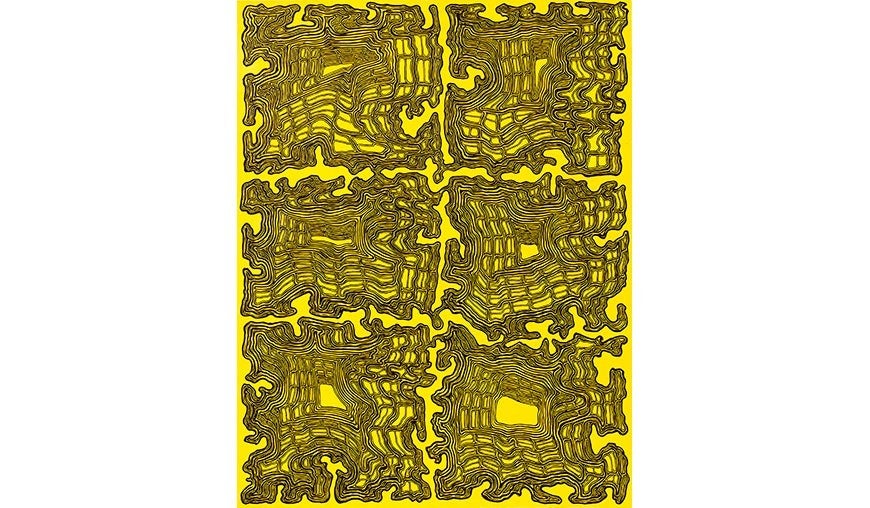CASCADE EFFECT

A solo exhibition of James Sienna.
Xippas Paris is pleased to present Cascade Effect, James Siena’s third personal exhibition with Xippas, featuring seven large-scale paintings and seven drawings. A pivotal artist from the New York art scene, James Siena is renowned for his elaborate abstract forms based on a combination of self-imposed restrictions – base units that he repeats – and unforeseen events.
For his exhibition Cascade Effect, Xippas Paris asked Brett Littman (former Director of the The Drawing Center in New York and currently Director of the Isamu Noguchi Foundation and Garden Museum in Long Island City) to investigate the two bodies of work presented for the exhibition.
Brett Littman: You chose to entitle your exhibition at Xippas Paris “Cascade Effect”. Can you explain why?
James Siena: In all my work there is causality and emergence; that is, each move made (and I’m on record saying, more than twenty years ago that “I don’t make marks, I make moves”) affects each subsequent move, and in the resonances and intervals between these events unforeseen events and effects emerge. Explicit in these new works are intervals of varying width which, when interlaced and articulated in various (but consistent within the system) ways, result in what appear to be cascades of forms. The works are primarily generated from the outside perimeter to the interior; thus the resonant cascades distort and transform as they are tracked by the viewer along various axial vectors.
BL: To demonstrate this, you are articulating two new bodies of work – 7 works on paper and seven paintings on canvas. Is there a difference between how you approach the different substrates and activities?
JS: There is a common thread running through both modes, that of generating an image through gestural rule limited drawing which iterates deliberate, focused, labor intensive articulation of the original gestural drawing. The
smaller drawings ironically reference the larger scale works, in a perverse way.
BL: All of the new works seem larger than what I have seen you do before. Is there a reason for scaling up?
JS: I resolved to make large scale paintings, partly because I saw a group of my large scale drawings (60 x 40 inches) on display at MoMA in 2016, in the lobby, and the ten of them framed really shook me up. They dwarfed the viewers
as they moved in and out of the space, and it occurred to me that I hadn’t dealt with large scale for decades, and it was like a switch was flipped, and I’ve not looked back.
BL: The graphite, charcoal and conte crayon works on paper remind me of torn lace or fabric. They have a more fragmented feel to them than some of your earlier systems/ patterns. Is this something that was conscious on your part?
JS: It was not a conscious decision, but the fragments you describe are exactly that. They are shapes generated by the initial drawing, sometimes in pencil, sometimes in charcoal or conte, that also is manifest in the paintings, but harder to see in reproduction. In most of the recent drawings, as of 2019,
there are two circuits of drawing, related to and dependent on each other, that generate voids which are then filled in in various ways. So fragmentation is one aspect of the image. The other, equally essential element is the resonant spacing between the circuits.
BL: You have been firmly committed to abstraction and in particular line-based abstraction now for about 30 years. Your work continues to evolve and change, which is fascinating to me, it is like you have found an algorithm that has endless permutations. What have you learned about image making and
yourself through this seeming open ended system?
JS: In these works, there is a freedom from rules and limitations and also, paradoxically, a rigorous adherence to ways of working that is now grandfathered in to my practice. I was much more consciously carrying out instructions in my earlier, smaller aluminum work, dealing with modes of dividing and containing the support in various divergent ways. In these new
works, I’m returning again and again to this circuitous drawing with resonant spacing, working from the outside in, structurally, and while there’s a deal of compression at the edge, the scale allows for more open space around the perimeter of the work. This is something I wasn’t aware of until I started making large paintings, and I’m very compelled by the sensation of being
surrounded, at close range, by the image, and also seeing the assertive presence of the work at a distance and at an angle.